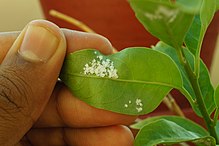Eriosomatinae
| Woolly aphids | |
|---|---|

| |
| Woolly aphid on jasmine leaf | |
| Scientific classification | |
| Domain: | Eukaryota |
| Kingdom: | Animalia |
| Phylum: | Arthropoda |
| Class: | Insecta |
| Order: | Hemiptera |
| Suborder: | Sternorrhyncha |
| Family: | Aphididae |
| Subfamily: | Eriosomatinae |
| Tribes[1] | |
| |




Woolly aphids (subfamily: Eriosomatinae) are sap-sucking insects that produce a filamentous waxy white covering which resembles cotton or wool. The adults are winged and move to new locations where they lay egg masses. The nymphs often form large cottony masses on twigs, for protection from predators.
Woolly aphids occur throughout the Northern Hemisphere. Many of the numerous species of woolly aphids have only one host plant species, or alternating generations on two specific hosts. They have been known to cause botanical damage and are often considered a pest. While most damage is minor, they can spread plant diseases and fungi. Some species can produce galls as well.[2]
In flight they have been described as looking like "flying mice." Other nicknames include "angel flies", “cotton fairies”, "fluff bugs", "fairy flies", "ash bugs", "snow bugs", "fluffer fairies", "poodle flies", “ghost bugs”, and "fluffy gnats".[citation needed]
Diet
[edit]Woolly aphids feed by inserting their needle-like mouthparts into plant tissue to withdraw sap. They are able to feed on leaves, buds, bark, and even the roots of the plant. As a result of feeding on the sap, woolly aphids produce a sticky substance known as honeydew, which can lead to sooty mold on the plant.
Botanical damage
[edit]Woolly aphids generally are not much cause for alarm, although they can cause rather unsightly damage to plants, which is particularly a problem for growers of ornamental plants. Symptoms caused by their feeding on a plant include twisted and curled leaves, yellowed foliage, poor plant growth, low plant vigor, and branch dieback.[citation needed]
The woolly apple aphid, Eriosoma lanigerum is a widespread pest of fruit trees, feeding principally on apple, but also, pears, hawthorn, ash, alders, elms and oaks.[1] Gall making species include Melaphis rhois and Pemphigus spp.
Further minor damage can be caused by the honeydew that woolly aphids secrete, which is difficult to remove. While the honeydew itself doesn't cause too much of a problem, the honeydew can cause sooty mold to grow, which can block some of the sunlight needed for photosynthesis.[citation needed]
Woolly aphids and other sucking insects are often vectors of transmission for powdery mildew (a white fungus which grows on above ground parts of some plants), and other infectious diseases. Typically wooly aphids in subtemperate climates precede and are an indicator of various plant infections, including powdery mildew. Aphids penetrate plant surfaces where they often reside and provide a host of potential inoculants through physical, digestive or fecal secretions. Aphids are often an indicator of other potential plant problems.[citation needed]
Taxonomy
[edit]The subfamily Eriosomatinae has recently been placed within the family Aphididae.[3][4][better source needed] It was previously placed in family Pemphigidae = Eriosomatidae,[5] but that taxon is no longer valid.[6][failed verification]
Tribes and genera
[edit]Tribe Eriosomatini
[edit]- Americanum
- Aphidounguis
- Byrsocryptoides
- Colopha
- Colophina
- Eriosoma
- Gharesia
- Hemipodaphis
- Kaltenbachiella
- Paracolopha
- Schizoneurata
- Schizoneurella
- Siciunguis
- Tetraneura
- Zelkovaphis
Tribe Fordini
[edit]Tribe Pemphigini
[edit]- Ceratopemphigiella
- Ceratopemphigus
- Clydesmithia
- Cornaphis
- Diprociphilus
- Epipemphigus
- Formosaphis
- Gootiella
- Grylloprociphilus
- Mimeuria
- Mordwilkoja
- Neopemphigus
- Neoprociphilus
- Pachypappa
- Pachypappella
- Patchiella
- Pemphigus
- Prociphilus
- Thecabius
- Tiliphagus
- Uichancoella
See also
[edit]References
[edit]- ^ Aphid Species File Version 5.0 (2014). "Eriosomatinae". Retrieved September 17, 2014.
((cite web)): CS1 maint: numeric names: authors list (link) - ^ Costa, James T. (2006-09-30). The Other Insect Societies. Harvard University Press. p. 221. ISBN 978-0-674-02163-1.
- ^ Favret et al. (2008) Transactions of the American Entomological Society 134 (3 & 4):275-282
- ^ Colin Favret & David C. Eades (2011). "Taxa display: family Aphididae Latreille". aphid.speciesfile.org. Retrieved October 19, 2011.
- ^ E.L. Maw, Checklist of the hemiptera of Canada and Alaska (2000). [page needed]
- ^ Colin Favret & David C. Eades (2011). "Aphid Species File homepage". aphid.speciesfile.org. Retrieved October 19, 2011.
Text is available under the CC BY-SA 4.0 license; additional terms may apply.
Images, videos and audio are available under their respective licenses.
